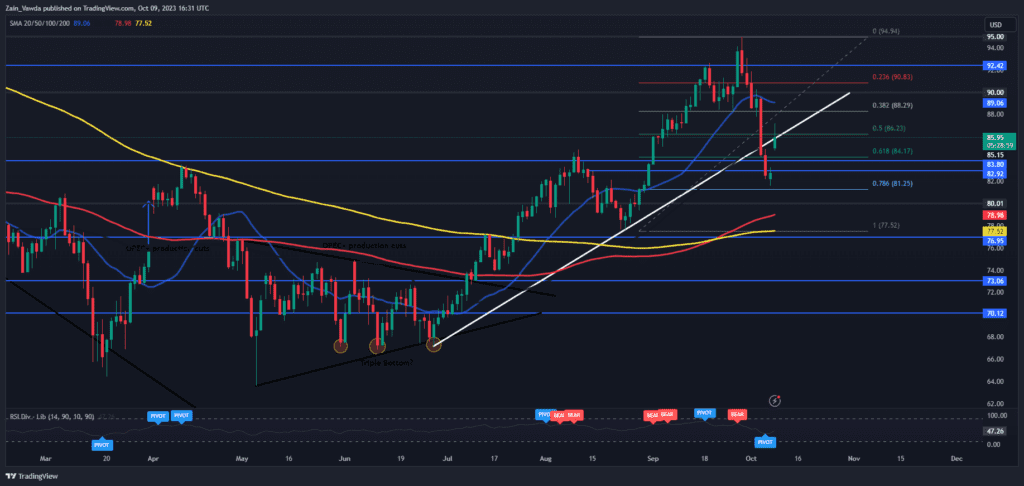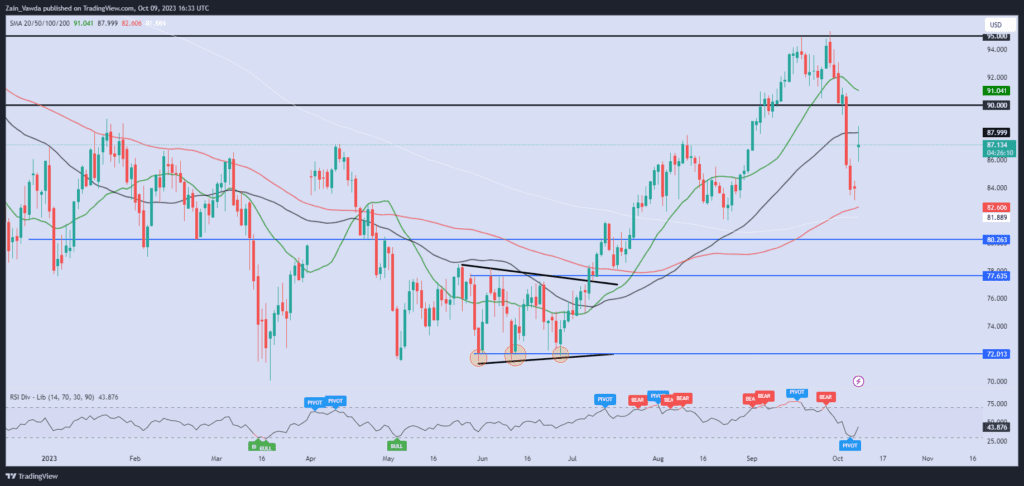Rising oil prices dominate market attention, underpinned by geopolitics and OPEC’s fresh forecasts.
In the labyrinth of global financial discourse, rising oil prices have emerged as the central thread. The world, already grappling with post-pandemic economic recovery, is now facing the tremors of an unstable energy sector. This volatility is not a simple consequence of supply and demand; it’s a product of an intricate web of factors, each playing its pivotal role in the grand scheme of things.
For starters, OPEC’s revised demand forecast adds a new dimension to the narrative. Historically, OPEC has been a bellwether for the oil industry, guiding and sometimes dictating the tempo of the market. Their latest pronouncements suggest a future where the demand for oil will likely surpass previous estimates. This revised outlook can be attributed to several factors, such as recovering economies thirsting for fuel, industries ramping up operations, and emerging markets expanding their infrastructural footprint.

However, it’s not just numbers and projections that sway the oil pendulum. The geopolitics of the Middle East, an area synonymous with vast oil reserves, adds layers of complexity to the situation. The region, historically fraught with conflicts, has seen heightened tensions, especially concerning the Israel-Palestine dynamics. These tensions can be disruptive, influencing not just local, but global oil supply chains. Any disturbance in the Middle East’s oil flow, whether due to political disagreements, sanctions, or open conflicts, reverberates across continents, impacting prices at every gas station and every household.
Governments worldwide are on high alert. For importing nations, rising oil prices can mean ballooning import bills, potential trade imbalances, and added inflationary pressures. Exporting nations, while benefiting from higher revenues, also walk a tightrope. They must ensure stable supply chains and navigate the quagmire of international politics and trade relations.

Investors, too, are recalibrating their strategies. The energy sector, a cornerstone of many investment portfolios, is in flux. Shareholders are now tasked with decoding not only corporate earnings and industry trends but also the geopolitical developments and their potential ramifications on the oil sector.
Lastly, one can’t ignore the end consumers, who often bear the brunt of these fluctuations. Rising oil prices trickle down to everyday lives, affecting everything from transportation costs to grocery bills. Households might find their budgets strained, and businesses, especially those heavily reliant on logistics, could see their operational costs surge.
As oil prices continue their ascent, they unravel a multi-dimensional challenge. The intertwined threads of post-pandemic economic recovery, OPEC’s forecasts, and Middle East geopolitics are creating a tapestry that stakeholders across the globe are striving to understand and navigate. The path forward might be riddled with uncertainties, but it’s a journey that the world is undertaking collectively.
The Surge in WTI/Oil Prices
West Texas Intermediate (WTI), a prominent and influential benchmark for global oil pricing, has become a key indicator of the ripples caused by geopolitical tensions. As we transitioned from one week to the next, WTI saw a notable shift, moving from a close of $82.74 a barrel to a reopening at approximately $85.00. This change wasn’t purely a consequence of natural market movements; it was heavily influenced by the escalating discord between Israel and Palestine.
These geopolitical tensions between the two nations have resonated beyond their borders, spreading apprehension in international markets. Market stakeholders are particularly anxious about the potential of this localized conflict morphing into a larger crisis that could envelop the expansive Middle East region. Amplifying these concerns are lingering speculations around the role and involvement of Iran, a pivotal player in the region. Despite the rampant conjecture, key global leaders have remained tight-lipped, refraining from making official statements or declarations on Iran’s stance or actions.

Source: TradingView
But geopolitics isn’t the sole driver of the oil market’s volatility. There are underlying economic and strategic considerations at play, too. Enter OPEC – the Organization of the Petroleum Exporting Countries. Their revised forecast for both medium and long-term oil demand has taken many by surprise. Previously, there were certain benchmarks and expectations set based on pre-pandemic data and trends. Still, OPEC’s new projections have upended these, suggesting a substantially heightened demand curve in the coming years.
To put this into perspective, OPEC’s data indicates that a staggering $14 trillion in investments would be required to adequately cater to this burgeoning demand. Such a lofty figure not only underscores the importance of oil in the modern world but also reinforces its indispensability in the foreseeable future, regardless of the swift technological advancements in alternative energy sources.
The Historical Lens: Oil Embargo 1973
When observing the contemporary fluctuations in oil markets, the shadow of history often looms large. The 1973 oil embargo serves as a pivotal reference point in this context. Orchestrated primarily by Saudi Arabia, along with other influential members of the Organization of Arab Petroleum Exporting Countries (OAPEC), the embargo was less about oil and more a political maneuver.
The primary grievance? Western nations’, especially the United States’, unwavering support for Israel amidst the Yom Kippur War. This embargo didn’t just result in a few days of oil scarcity; it ushered in an era of profound global energy market transformations.
For current market stakeholders, the lessons of 1973 are not forgotten. The mere mention of an embargo evokes the specters of shortages, skyrocketing prices, and global economic disarray. With Saudi Arabia now at the negotiation table with Israel, the market is understandably skittish about any potential parallels with the past. Yet, most experts argue that drawing a direct comparison between then and now might be an oversimplification.
Today’s geopolitical and diplomatic dynamics, especially the intricate dance between the U.S., Saudi Arabia, and Israel, stand distinct from those of the 1970s. The ongoing discussions surrounding the normalization of ties between Saudi Arabia and Israel, bolstered by the prospect of a defense agreement with the U.S., is a testament to the evolving landscape.
Nevertheless, the situation in Iran provides another layer of complexity. Iran’s oil production has witnessed a noticeable upsurge over the past year. This surge effectively balances out the production cuts initiated by heavyweights like Russia and Saudi Arabia. But, with growing animosity and allegations against the current Iranian administration, whispers of tightened sanctions are becoming increasingly loud. As the West contemplates its next move, the global oil market remains on tenterhooks, anticipating the ripple effects of any major geopolitical decisions.
Rising Oil Prices and the Global Economy
The uptrend in oil prices is more than a mere headline for those immersed in economic charts and graphs; it’s a reality that strikes the core of everyday living for billions worldwide. Rising oil prices, seemingly a matter reserved for financial analysts and investors, have far-reaching implications that touch every household. The pivotal connection? The intricate and inescapable web of the global economy.
Imagine your morning commute, the goods at your local supermarket, or the cost of heating your home during winter. Oil prices exert a profound influence on all these facets of daily life. An upward tick in the price of oil doesn’t just reflect at gas stations; it permeates various sectors. Transportation companies grappling with increased fuel costs might pass on the burden to consumers. Manufacturers dealing with pricier raw materials and operational expenses due to expensive oil might increase the price tags of their products. In essence, the ripples of oil price fluctuations can soon turn into waves that impact the global cost of living.
Last week’s oil selloff, while greeted with a sigh of relief by Central Banks and ordinary consumers alike, was short-lived. As oil prices once again flirt with figures above the $86 a barrel threshold, the ghosts of inflation — which seemed dormant — might reawaken. The undercurrents of rising costs could challenge household budgets and force financial policymakers to rethink strategies.
The present surge in oil prices isn’t just a tale of supply and demand dynamics; it’s deeply intertwined with global geopolitics. The Israel-Palestine conflict stands front and center in this scenario. As tensions escalate, the consequent geopolitical chess game has the potential to redraw the landscape of Middle East alliances. Such realignments, in turn, hold the power to reshape global oil supply routes and dynamics. In such a delicate balance, the price of oil becomes not just an economic indicator but a barometer of global stability.
Technical Outlook and Market Projections
In the world of trading, a mix of news-driven dynamics and technical patterns often determine the course of commodity prices. Lately, the technical landscape of oil prices, especially for benchmarks like WTI and Brent, provides insightful clues about their near-term trajectories.
Diving into the charts, it’s evident that WTI and Brent showcased bullish tendencies as they opened higher in recent overnight sessions. Such positive openings can often be indicative of strong underlying sentiment. Yet, every rally, no matter how strong, is occasionally tested by periods of consolidation or retracement. This was observed in the slight market retreat during the subsequent U.S. trading session. Drawing from historical data, one can postulate that a substantial upward gap in oil prices – akin to what we’ve seen recently – could imply a cooling-off period. The market might undergo a phase of consolidation or even minor correction before resuming its dominant trend, potentially spanning close to 20 days based on past behaviors.

Source: Tradingview
Now, turning our gaze to Brent Crude – it’s fascinating to observe its dance in tandem with WTI. They often echo each other’s sentiments, albeit with minor deviations. Brent’s recent surge didn’t go unchallenged. It encountered a formidable barrier around the $88 price point, coinciding with its 50-day Moving Average (MA). This technical resistance can be a point of intrigue for chartists and traders, signifying a battleground between bulls and bears.
For those who swear by technical analysis, keeping an eagle eye on specific price levels becomes paramount. In the current setup, a few levels stand out. On the downside, the support zones to watch out for are 81.25, 80.00, and more crucially, the 100-day Simple Moving Average (SMA) marked at 78.98. Flipping the script, if the bullish fervor continues, resistance zones at 87.00 and 88.30 will be keenly observed, with the 90.00 mark standing as a psychological barrier.
In conclusion, while geopolitical events and macroeconomic data steer the broader narrative, the technical contours drawn on the charts offer traders a roadmap. In the intertwining world of fundamentals and technicals, understanding these levels and patterns is crucial for anticipating market moves.
Conclusion
Rising oil prices, amidst the backdrop of the OPEC’s upgraded demand forecast and the simmering Middle East tensions, present both challenges and opportunities. It serves as a reminder of the intricate interconnectedness of geopolitics, energy markets, and global economic health. As events unfold, a close eye on the OPEC’s moves, Middle East developments, and global market responses will be crucial in navigating the tides of the post-pandemic world.
Click here to read our latest article on USD/JPY Faces Alarming Dip as Dollar Index Wavers

